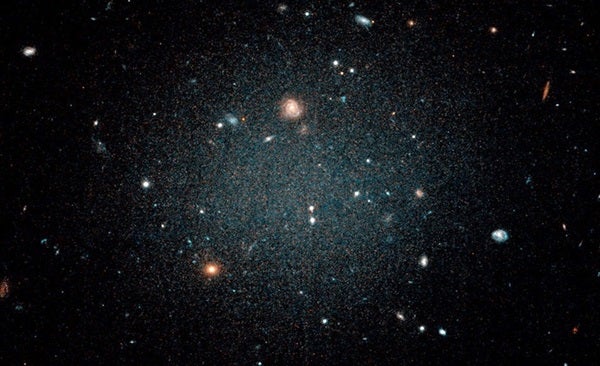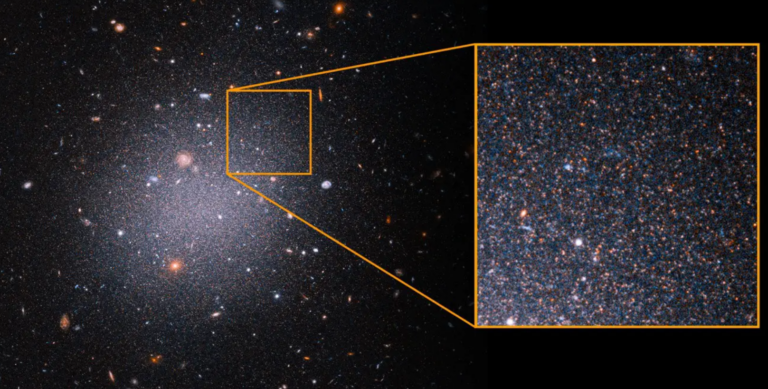19 Newly Found Galaxies Without Dark Matter Lead to New Insights on Galaxy Formation
Scientists have discovered nineteen more galaxies where dark matter could not be detected. These strange galaxies are usually composed of ordinary matter, that is, protons, neutrons, and electrons that constitute everything known to man as opposed to dark matter. The recent and more disputed finding of two other galaxies devoid of dark matter is confirmed by the new one published in Nature Astronomy.
Dark matter is, in fact, the dominant constituent of the universe, and it is purposed to be the root of galaxies formation and an essential component of galaxies. The constraints imposed by the lack of such exotic matter in so many galaxies suggest that astronomers are fundamentally not comprehending the origin and development of galaxies.

Lead author Qi Guo of the Chinese Academy of Science, in a press release, said, “This result is very hard to explain using the standard galaxy formation model and thus encourages people to revisit the nature of dark matter. ”
Dark matter and galaxy rotation
The most famous observation of the nearest galaxy, the Andromeda galaxy, was conducted by Vera Rubin and Kent Ford from the Carnegie Institution in the late 1970s. When they did the calculations they discovered that the galaxy was not rotating in the way they had expected it to. In our solar system, the planets revolve in their orbits in different speeds and time periods. Mercury has higher angular velocity when seen in close up than Neptune is seen from telescope miles away. In Andromeda, the objects, which can be seen on the peripheral of the galaxy, move with the same speed as the objects in the inner area of the galaxy. Ford and Rubin were perplexed.
This gave the indication that huge amounts of this intangible substance must exist throughout Andromeda galaxy and not just in its core. And thus, their discovery was the first tangible evidence of the existence of dark matter in the universe. The subsequent decades saw astronomers postulating that there was dark matter around the galaxy: a material object that can only be detected through its gravitational pull on the other objects of the universe.
Then, in 2018, an unusual, ethereal galaxy called ‘NGC 1052-DF2,’ was identified by researchers led by Pieter van Dokkum from Yale University. It seemed to contain almost negligible quantity of dark matter or actually no dark matter at all. “We believed that each galaxy had dark matter and that the dark matter is the starting point of a galaxy formation,’ van Dokkum explained in a press release of the discovery made.
This stuff is highly mysterious and intangible and yet it controls every galaxy. The presence of a galaxy without it is thus rather surprising. It goes against traditional theories of how galaxies operate from environments and also proves the existence of dark matter which is separate from the remaining portions of galaxies.
A few months later, NGC 1052-DF4 was discovered by van Dokkum and colleagues as a second galaxy without of significant dark matter. Similar to NGC 1052-DF2, this ultra-diffuse galaxy caused some controversy among astronomers.
Ignacio Trujillo, an astronomer at the Instituto de Astrofisica de Canarias in Spain, was among the critics.
“Something that caught my attention very early on was the fact that the galaxy [DF2] was not only anomalous for not having dark matter, but also for having an extraordinarily bright population of globular clusters,” Trujillo told Astronomy. “I remember thinking: ‘Two anomalies at the same time really looks odd.’”

But after an academic back-in-forth, where Trujillo and van Dokkum traded salvos in the form of research papers, the answer to whether these galaxies are really missing their dark matter still remains uncertain.
A growing list of galaxies without dark matter
However, the absence of dark matter to be found in 19 additional galaxies has therefore reduced the peculiarity of both DF2 and DF4. Moreover, the most recent observations are going to pose some challenges to astronomers, as they will have to dedicate a considerable amount of thought to the consequences of the presence of this new type of galaxies that do not contain dark matter. In the analysis of Guo and her team, the properties of 324 dwarf galaxies were investigated with data from the Arecibo Observatory in Puerto Rico and the Sloan Digital Sky Survey, and it appears that the latest group of galaxies has no hint of dark matter.
They also examined the pattern in the rate at which the hydrogen gas around these galaxies rotate, a research that was previously carried out by Rubin and Ford, from this data. This they did to compute the masses of normal matter present in the galaxies which encompassed stars and gaseous materials. In a study that included some calculations, Guo and her peers observed that only 19 of the 324 researched dwarf galaxies provided sufficient visible matter to explain the velocities of hydrogen only in the galaxies.
In other words, these galaxies seem to have a much smaller mass of dark matter as compared to other observed galaxies. In this study, the researchers pointed out, “Our findings indicate that a class of dwarf galaxies could have formed in a specific manner, and it implies that significantly lower amounts of dark matter is involved than those found in Local Group or in simulations. ”What are the implications the discovery of galaxies lacking dark matter?What he says is that this would suggest that what has been said regarding the formation of galaxies is not the full story. At the present time and relied on some hypotheses, galaxies can only form if the gas and dust needed to start the formation of stars can be attracted by large amounts of dark matter inherent in it.
“The point is, we could not even fathom how star formation proceeds in the complete absence of the dark matter,” as van Dokkum remarked. “All we can say is that the necessarily there existed very dense gas in the early stages of their evolution. ” Even the galaxies could not form new stars if they could not.
Guo and her colleagues indicate that in the future, additional work should be done by astronomers to map the motions of hydrogen gas inside these galaxies. And with that, they hope to discover more about the initial processes leading to the formation of these galaxies devoid of dark matter.
Do not forget to share your opinion with us to provide you with the best posts !




0 Comments